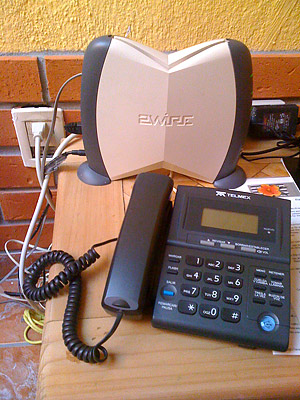We packed and stored everything we owned, sold one car and lent the other one to some friends, and let go of our beautiful apartment in San Francisco. We even figured out a fun way to get rid of our 85-bottle tequila collection. (There’s much more on that story to come.)
Finally, almost a week later, we’re starting to settle down here in Mexico. The weeks leading up to our move were hectic. Until recently, neither of us ever would have imagined that we’d be living full-time in the land of tequila.

We arrived in Guadalajara Thursday night, along with eight suitcases cases—four containing computer and camera equipment and four filled with clothes and personal items.
If you’ve ever been through a Mexican airport, you’re familiar with “the button.” As you go through customs, you need to press a big button, and if the light turns green, you can continue through without disruption. If the light turns red, they pull you aside and look at every single item in every one of your bags – essentially learning everything about your life by looking though what you’ve got packed.
In all our previous trips, we have had nothing but green lights into Mexico.
This time, with a cart loaded up with 8 large over-stuffed bags at the Guadalajara airport, somehow we knew that we would push the button and get the red light. I almost started to feel sorry for the security guy who had to tug and lift our suitcases to probe his hands through all of our stuff.
Grover’s camera bag, loaded to the max with gear, was one of the first to be checked. Right away we were asked if we were professional journalists. We said no – that we run a blog, and that seemed to be OK. Bag-by-bag he continued to search, but by the seventh suitcase he seemed to stop searching as thoroughly and eventually waved us through. Grover strategically placed the largest bag (which contained telephone and networking gear and several external hard drives) at the bottom hoping that this would be the case.
Several hours earlier, while still in our San Francisco apartment, we were already trying to figure out how we were going to get a large van-sized taxi at the Guadalajara airport. So imagine our surprise when our very determined taxi driver was able to fit all of our bags into one small taxicab. Our driver managed to do this (quite ingeniously) by repeatedly shoving everything into the trunk and slamming the door until it fit.
He drove us to our rented apartment in downtown Tlaquepaque. We had only seen pictures of the apartment on the Internet and were pleasantly surprised to find that it is even bigger and nicer than we imagined. But that wasn’t our biggest concern.
Almost immediately, we threw down our bags and grabbed our laptops to check the speed of the Internet connection. Disappointment. The download speed was not too bad but the upload speed—which is really important for us to be able to upload pictures and videos to this site—was slower than an old-school, dial-up modem.

Grover ran some diagnostics on the network, and learned it was a retro DSL connection – the same type that he had 10 years before in his apartment in San Francisco.
After doing some research, we figured out that our best solution would be a 3G WiFi card. There are several on the market, and one in particular allows us to connect several devices at once, including our iPhones, by creating a local WiFi network.
We spent eight hours (literally, no exaggeration) researching and finding the right card. We went from store to store and mall to mall until we finally found a solution.
Exhausted, we then hit La Faena, our new favorite mariachi bar in Guadalajara. If you buy an entire bottle of tequila in the bar, they will continuously bring you free and delicious food for the rest of the evening. They start with soup and snacks and eventually you get a steak, all accompanied by live mariachi music, singing families and a crooner wearing a lucha libre mask. Ah, Mexico!
But soon, our mariachi high was doused when we got home and discovered that our WiFi card didn’t work. Grover spent hours trying configure it using the various numbers, cryptic codes and directions (all Spanish) before he finally gave up.
We decided that we would go to the Iusacell offices (which sells the cards) first thing Monday morning to get it working. Our plan – to bring the device, and our MacBook, and not leave until they made it work.
Being as prepared as possible, we printed out a map with directions to our destination, and made our way to the taxi stand. We jumped into a cab driven by an old man who, we eventually learned, could not read – so he ignored the maps we gave him and instead yelled the same thing over and over while driving 90 miles an hour and weaving through rush-hour traffic.
Somehow we managed to drive past our destination at high speed, so we yelled “ESTAMOS AQUI!” (“we’re here!”) and he slammed on the brakes, and let us out.
Once we arrived at the offices, somewhat seasick and spent, we waited almost three hours for them to make it all work. The steps involved?

1) Fix an error they found on the card.
2) Activate the card. (A multi-step process that required three different people.)
3) Register us with the Mexican government. (Apparently a new law has taken effect that every cell phone—which includes WiFi cards—must be registered to keep them from being stolen and to track possible narco-traffickers.)
There was no way we could have done this by ourselves.
So now, we have a better Internet connection but it’s still not great. Like any 3G network, when it is saturated, everything slows down. Only one of us can send files or do bandwidth-heavy work at a time. Despite this, we are elated to be here and start our tequila adventures.
We asked Olivia (our landlord) if there was any way we could upgrade the network, expecting a polite “no.” Just a few minutes ago, there was a knock at our door with some great news—she is going to install a cable modem capable of the kind of connection we had in our apartment in San Francisco.
“Hay una solución todo en México, excepto en muerte,” Olivia told us. (“There is a solution to everything in Mexico, except in death.”)
We have some very exciting news and stories to announce over the next couple of weeks. Stay tuned, because this is just the beginning.
-Scarlet





I’m GIDDY with excitement, you two!
Keep us posted. We’re hanging on EVERY WORD!
Wow this seems like an amazing adventure for two folks from SF.
I wireless nightmare seems more then I could manage. Good thing Grover is a Genius!
Take Care
Robert
WOW! What an adventure! Looking forward to following your blog. I gotta get to Mexico. A bottle of tequila, mariachi, and food all night long is my idea of a good time.
No, friggin’ WAY. Mexico? Dude, I am jealous of your adventurous spirit.
Hello,
Welcome to Mexico. Had a lot of fun with your post. We live with that everyday. Expensive and slow internet service. The great thing you moved to Guadalajara is that is a second largest city in Mexico, so you have technology service at hand. If by any chance you come to Monterrey please send me a line and I will show you here.
Hey Bro
Glad you guys got there safe, I’m so jealous, that was a real gutsy move to pick up & leave beautiful SF. Please enjoy yourselves, drink lots of tequila for me, as that is what your old sis loves to drink also. Lets get together in ole Mexico & drink a toast to your new home!!
Grover, welcome to tequila land, I can just imagine what the adventure you just passed, as Alvaro mention, our internet services in Mexico are not compared anything close to the ones you have in the States, they are slow and expensive, I live close to the Guadalajara airport and am a enthusiast photographer and make my living working in a US company doing software development, I don’t really know many bars and I’m not a tequila expert but if you want I can show you the city and maybe can give you some tips to get your adventure more pleasant.
great to hear you guys are there finally and have in Mexico which i was there il be heading there in December to visit family members in Guanajuato
Welcome again to Gdl.
It is exciting to meet people like u that are very interested in one of our Mexican roots, the Tequila spirit.
Sometimes it is disappointing that Americans know much more about Tequila than many many Mexico city cents. “Sip it, don’t slam it” and many other words and phrases were found by me in web and blog sites like Tequila.net, Tastetequila.com and some others. But it is really nice too, that Tequila goes abroad and makes such experiences and relationships.
Hope you have a successful and wonderful trip to the Tequila Land.
Mucha suerte en su travesía y de manera cordial, sean ustedes bienvenidos.
I was born and raised a 10-minute walk from San Pedro Tlaquepaque… I grew up calling it “tlaquepulgas”… It’s a nice part of town, no doubt about it, BUT SF is the CITY… I wish I could afford to live there…
Having said that, YOU guys are CRAZY… in the best sense of the word… enjoy Guanatos!!!
Alejando: We love it here in Tlaquepaque! San Francisco is the best city in the USA, though, and we’ll be back. But for now, Tlaquepaque is our home.
I applaud you guys for making such a giant leap! I have often dreamed of getting out of the “rat race” myself and relocating with my wife in Mexico. If I may ask, how is the economy in Tlaquepaque? Are the rents fairly reasonable and are there any chances for employment in the area for Americans?
Best wishes!